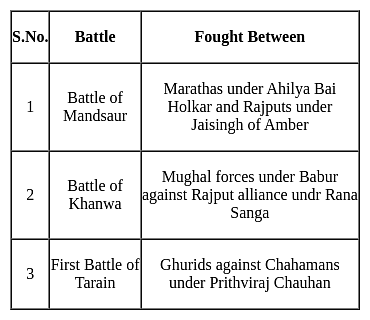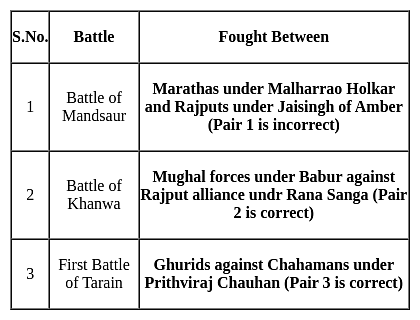APSET Paper 2 Mock Test - 9 (History) - AP TET MCQ
30 Questions MCQ Test APSET Mock Test Series 2025 - APSET Paper 2 Mock Test - 9 (History)
Which kingdom's ruler signed the treaty with British East India company in the year 1817 ?
Consider the following statements with respect to the Kalighat folk painting:
- It was first of its kind in the Indian subcontinent that expressed subaltern sentiment and addressed customers directly.
- It started on a religious note however overtime social sentiment were expressed.
Which of the statements given above is/are correct?
| 1 Crore+ students have signed up on EduRev. Have you? Download the App |
Consider the following about the prehistoric paintings in India.
- This art shows symbolism where man took the inspiration mainly from nature.
- There was depiction of limited and special subjects.
- There was no mention of spirituality in them
- It was the local Indians who first discovered these paintings.
Select the incorrect code :
Choose the incorrect statements:
1) Bahadur Shah made peace with Banda Bahadur, the Sikh chief after the death of Guru Gobind Singh.
2) However, the Bundela chief, Chhatarsal and the Jat chief Churaman joined hands with each other in the campaign against the Mughals.
By the act of 1786, the Governor General of India could override the decisions of his council only if ____?
Consider the following statements about the provisions of the C. Rajagopalachari Formula:
1. Muslim League to endorse Congress's demand for independence.
2. Only the Muslims of North-West and North-East to vote in the plebiscite and not the entire population, in case of partition.
3. In case of acceptance of partition, agreement to be made jointly for safeguarding defense, commerce, communications, etc.
Which of the above statement(s) is/are correct?
Who was the first President of the All India Trade Union Congress established in 1920?
Balathal is an archaeological site located in:
Who among the following was also known as Gadadhar Chattopadhyay?
Consider the following statements, with reference to the Magadha empire.
- Warriors and priests, i.e., the Kshatriyas and the Brahmanas, were exempted from the payment of taxes.
- Bali became a compulsory payment to be made by the peasants in the age of Buddha.
Choose the correct statement.
Consider the following statement:
1. The most known princes of Mahakaushal region were brothers Aalhaa and Udal.
2. Baghelkhand was earlier ruled by the Kalacuri dynasty.
Which of the above statements is/are correct?
Consider the following statements about Mughal architecture.
1. It retained features from Sultanate architecture such as the bulbous dome and rectangular garden settings.
2. Features from the provincial styles of Gujarat, Malwa, Rajasthan, Sharqi kingdom and Bengal were adopted.
3. New fashions were introduced from Central Asia and Iran such as the arch and vault.
Which of the above statements is/are correct?Vrata, gana, grama and sardha are related to which of the following?
Which painting is considered to be the ‘fountainhead of all the classic paintings in Asia’?
With reference to the states that emerged with the decline of the Mughals, consider the following statements:
1. Most of these states adopted the Mughal style of administration.
2. The politics of these states were invariably communal.
3. The rulers of these states succeeded in mitigating the economic crisis that emerged in the late 17th century.
4. The position of peasants in these states continued to deteriorate.
Which of the following statements given above is/are correct?
- It was formed by Pitts India Act of 1784
- It controlled the commercial matters of the company
- It was abolished by the Government of India Act 1858
Which of the following is a collection of magic spells and charms to ward off the evil spirits and diseases?
Which of the following is true in the context of 'East India Company '?
A. In 1690, the East India Company acquired a charter from the ruler of England, Queen Elizabeth II.
B. With this charter the Company ventured across new lands from which it bought goods at a cheap price, and carry them back to Europe to sell at higher prices
C. The royal charter prevented other European powers from entering the Eastern markets.
D. Vasco da Gama an English explorer discovered this sea route to India in 1498.
Consider the following pairs.

Which of the above pairs are correctly matched?
Consider the following statements regarding the Bhakti Movement.
1. Bhakti means love and devotional surrender to God.
2. The term Bhakti first appeared in Vyasa’s Bhagavad Gita.
Which of the above statements is/are correct?Which of the following is associated with Megaliths?
Khajuraho temples are located in which of the following districts?
Consider the following statements regarding the Industrial Policy Resolution of 1948?
(1) 3 Fold classification of Industries.
(2) Public sector industries were called Key Industries
Select the correct answer using the code given below.Consider the following statements regarding the achievements of Aryabhatta :
i. He was the first astronomer to give a scientific explanation of eclipses.
ii. He was also the first to discover that earth rotates on its axis.
iii. He gave an extremely accurate estimate of the length of a year.
iv. He gave very accurate value of pi.
Which of the above statements are correct?
|
60 tests
|


















